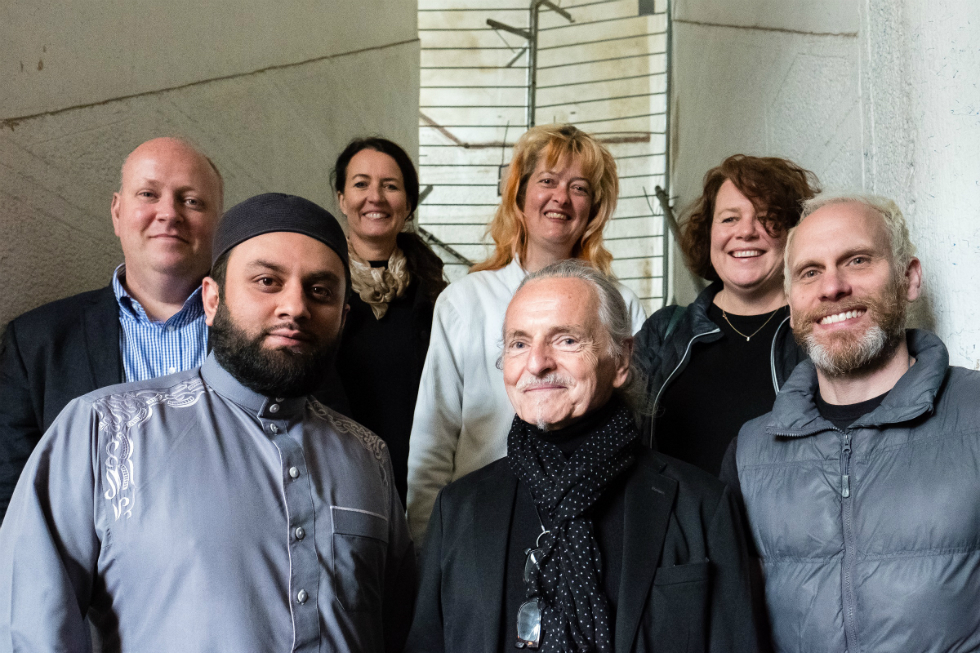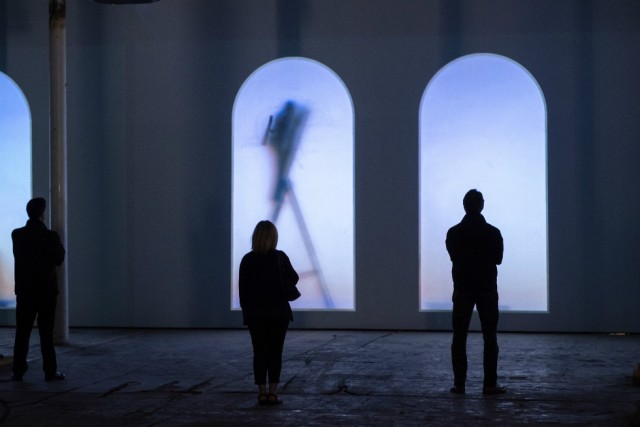“Where the figures are foggy, the voices are clear…” Krzysztof Wodiczko’s Guests — Reviewed

The latest to take part in the Liverpool Biennial Tour, artist Krzysztof Wodiczko finds ways to open up space where his guests — migrant subjects and exhibition visitors — may speak and, just maybe, be heard, finds Liz Mitchell…
What is a shadow? The displacement of light by mass. I cast a shadow because I occupy space in the world. Most of the time I do not think about the fact that space is mine to occupy. It is a given. But there are people for whom no space is allotted, whose space has been destroyed, or taken away, who are continually moved on, or who occupy the minimum amount of space they can get away with, as quietly as possible, so as not to be noticed and moved on again. Such people are all around you.
The word “guest” contains the invitation to occupy space. I am uncertain, though, who the guests are in this installation by Polish artist Krzysztof Wodiczko at Brierfield Mill in Pendle. Is it the ghostly silhouetted figures projected onto the wall of this 19th century cotton mill, or is it the audience, similarly silhouetted in the cavernous darkened room, against the flickering light?
Four pairs of arched, projected windows run along the far wall of the room. They form a colonnade, echoing the rows of iron columns holding up the barrel-vaulted ceiling of this once busy factory. Behind the windows, people are going about their lives, in a series of framed tableaux of moving images. But this is life seen through frosted glass, darkly. Indistinct figures in silhouette stand in groups chatting. A man with a briefcase talks into a telephone. A woman hands over a small child. At one end of the room, workmen and cleaners go about their tasks, quietly, with dignity, while at the other end people tussle with umbrellas.
Voices echo through the room, mixed up with the ambient sounds of rain, drills, a far off police siren. But where the figures are foggy, the voices are clear. They offer testimony, accounts of the real life experiences of migrants, both legal and illegal, across Europe. The man with the briefcase is not a businessman but a refugee, newly arrived in Poland and unable to speak the language. There is talk of identity papers, residence permits, of leaving behind loved ones. A woman is given residency and told to leave the centre where she and her children live. This should be good news, but where is she to go, she asks, bewildered.
Wodiczko’s installation is a poignant combination of the particular and the universal. These are real people, real lives, but under cover of shadow where they are both seen and not seen, they could be anyone, everyone. The lone woman who presses her hands to the window, who seems to look desperately, blindly, through the glass into the space I occupy, could, in other circumstances, be me.

One might be forgiven for assuming that Wodiczko’s Guests was made specifically for this time and place – a post-industrial Lancashire town with a diverse population built on migration, in a country currently divided over the issue. It speaks so eloquently to the location. Brierfield Mill once housed both white British and South Asian textile workers, immigrants of the 1960s who formed the basis of the town’s present day Pakistani Muslim community. In 2013, nearby Blackburn with Darwen was in the top third of British local authorities for immigration levels as a designated Asylum Dispersal Area. Last year, all 14 Lancashire districts voted in favour of leaving the EU. Migration is an issue that affects everyone.
But this is actually the third showing of this artwork, first seen at the Venice Biennale in 2009 and more recently in Wodiczko’s retrospective at FACT as part of the 2016 Liverpool Biennial. It is showing here as the third of the Biennial’s Touring Programme exhibitions, organised in partnership with arts venues across the North of England. Partnership in this case is with In-Situ, the artist-led, not-for-profit, Pendle-based arts organisation rapidly gaining a reputation for its international collaborations.
Guests feels deeply appropriate to its setting here – I can’t help feeling more so than in the context of biennale/biennial. Mill buildings are scattered throughout the North-West, many of them derelict, some (including Brierfield) the subject of regeneration and development. They are monumental buildings indelibly stamped on the psyche of their communities, a permanent reminder of what the function of that community used to be – a workforce. Art, some might say, isn’t meant to be functional. But I think the founders of In-Situ, Paul Hartley, Kerry Morrison and William Titley, would disagree.
Their concept of art is of something deeply embedded in place and community, as much a part of people’s lives as the shops on the high street – or once upon a time, the mill down the road. It is art which resides in relationships, in which artist, participant and audience come together to make the work. In so doing (to paraphrase Suzanne Lacy, a past In-Situ collaborator), they affect and transform the world. With an ambitious range of projects, from residencies and internships to the recently established Northern Faculty of Social Art Practice, In-Situ explores collaborative art practice as a way of bringing new insight to social conditions. In this, they share common ground with Krzysztof Wodiczko.
Both speak of trust as key to what they do. For Hartley, Morrison and Titley, it is building relationships slowly, on the ground, over time. It is giving artists a free hand to respond openly to the situation before them, without prescribing the outcome. And it is making and sharing work that challenges the imagination, that enables new forms of dialogue to emerge. For Wodiczko, it is building relationships with marginalised and outcast people, of finding ways to open up space where they may speak and, just maybe, be heard.
It is a match well-made. Partnership, like community, is one of those buzzwords that politicians and funders love to hear. The partnerships embarked on by the Liverpool Biennial with this touring programme are intended to enable greater access to the wealth of contemporary art brought together for three intense and crowded months in one city. But to work effectively, to be more than just lip service to hazy notions of inclusion, or the distribution of largesse from the centre to the margins, requires equality and trust between partners. It needs to do something new, something relevant to a changed set of circumstances. It is a testimony to both partners that this does.
Guests may not bring hoards of informed art lovers to the town (though I would highly recommend a visit). But that is not its point. It did bring Ozzie, a young boy from the estate up the road, about to start secondary school, wandering down to the mill that is part of his history, curious to find out what was going on. It introduced Ozzie to his soon-to-be head teacher, recently appointed to a school in special measures, who also happened to be there, and opened up a space in which they could talk. Ozzie is now part of In-Situ. Who knows what, if anything, will come of this? We must take it on trust that something will.
Liz Mitchell
See Krzysztof Wodiczko: Guests at Northlight (Brierfield) Mill, Brierfield, Pendle until 11 June 2017
This original article has been co-commissioned by Liverpool Biennial and The Double Negative to celebrate the Biennial’s Touring Programme in 2017-8. The tour sees artworks by leading international artists who exhibited at the 2016 Biennial travel to six different locations in Northern England: Barnsley, Brierfield, Bury, Leeds, Leigh and Rochdale. Read more here
Images, top: Clockwise – Dean Langton (Pendle Borough Council), Julie Palmer (Pendle Borough Council), Kerry Morrison (In-Situ), Sally Tallant (Liverpool Biennial), Paul Hartley (In-Situ), Krzysztof Wodiczko (Artist) and community member at the launch of Guests.
Centre: Visitors to Krzysztof Wodiczko’s Guests at Northlight (Brierfield) Mill. Photo: Pete Carr © Liverpool Biennial





